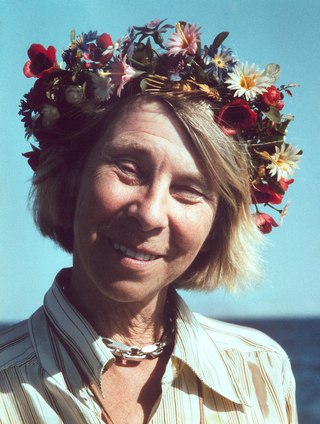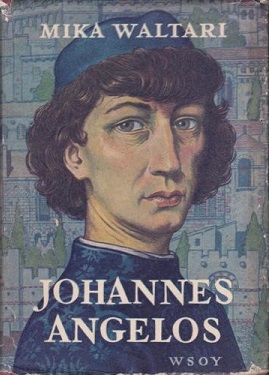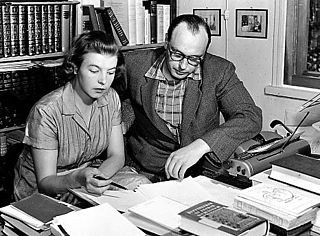
Tove Marika Jansson was a Swedish-speaking Finnish author, novelist, painter, illustrator and comic strip author. Brought up by artistic parents, Jansson studied art from 1930 to 1938 in Helsinki, Stockholm, and Paris. She held her first solo art exhibition in 1943. Over the same period, she penned short stories and articles for publication, and subsequently drew illustrations for book covers, advertisements, and postcards. She continued her work as an artist and writer for the rest of her life.

Ukko, Äijä or Äijö, parallel to Uku in Estonian mythology, is the god of the sky, weather, harvest, and thunder in Finnish mythology.

Lauri Kristian Relander was the second president of Finland (1925–1931). A prominent member of the Agrarian League, he served as a member of Parliament, and as Speaker, before his election as President.

The Dark Angel is a novel by Finnish author Mika Waltari about a hopeless love affair and the Fall of Constantinople. The Finnish version was originally published in 1952, with an English edition being published in Great Britain in 1953.

Finland competed at the Summer Olympic Games for the first time at the 1908 Summer Olympics in London, United Kingdom. The Grand Duchy of Finland was part of the Russian Empire at the time, but Finland had become a sovereign member of the International Olympic Committee in 1907.
Tammi, also known as Kustannusyhtiö Tammi and Tammi Publishers, is a Finnish publishing company established in 1943 by an initiative of Väinö Tanner, leader of the Social Democratic Party of Finland. In 1996, the company was bought by the Bonnier Group, and, as of the early 2000s, it was the third largest book publisher in Finland. In 2018, the company was merged into the Finnish book publishing company Werner Söderström Osakeyhtiö (WSOY). Tammi was formerly known as Kustannusosakeyhtiö Tammi.

Sara Kristiina Mustonen was a Finnish alpine skier. She is the youngest skier ever to win the Finnish alpine ski championship with her gold medal in the women's slalom in 1977 when she was only 14 years old.
Glenda Dawn Goss is an American author and music historian whose special interests are music and culture, early modernism, critical editing, and European-American points of cultural contact. Her most notable work has revolved around the life and works of the Finnish composer, Jean Sibelius.

Arvo Albin Turtiainen was a Finnish writer and translator.

Arvo Leander Lindén, later Linko was a Finnish wrestler, who won an Olympic bronze medal in Greco-Roman wrestling in 1908.

Säde Eila Talvikki Pennanen was a Finnish writer, critic, essayist, and translator. A key contributor to nurturing Finnish literature, she published approximately twenty novels and a number of short stories and plays. She worked for 40 years as a literary critic and wrote essays for magazines. Pennanen translated a hundred books, trained translators, and lectured.

Ella Margareta Kivikoski was the first Finnish female to earn a doctorate in archaeology in Finland. In 1931, she studied at the Baltic Institute in Stockholm and developed a scholarly working relationship with the Estonian archaeologist Harri Moora. She was a Professor of Archaeology at the University of Helsinki from 1948 until 1969, specializing in both Finnish and Nordic archaeology. Her specialty was the Finnish Iron Age.

Arthur Gunnar Lönnqvist was a Finnish photographer and businessman.

Johan Alfred Tanner, better known as J. Alfred Tanner, was a Finnish singer and songwriter. He is considered as one of Finland's most important songwriters ever, he wrote the lyrics to over 100 songs and recorded about 70 of them.

Ruth Helena Anhava was a prolific Finnish poet, author and translator. Her translations include novels, plays, lyrics and dozens of auditions.

Juhani Konkka was an Ingrian Finnish writer, translator, screenwriter and politician.

Gunnar Emil von Hertzen was a Finnish Jaeger officer and the planner of the Aunus expedition (1919). He was a physician by profession and served as a physician during the Winter and Continuation Wars, becoming a lieutenant colonel in medical corps. He also took part in Nazi organisations in the 1930s and 1940s.

Einar Nikolai Mäkinen was a Finnish lieutenant general and a member of the Jäger movement. He participated in the Eastern Front of World War I, the Finnish Civil War, the Winter War and the Continuation War. Before the Continuation War, he participated in negotiations with the Germans regarding plans for the war.
The IV Corps was a unit of the Finnish Army during the Continuation War. During the 1941 Finnish invasion of the Karelian Isthmus, it encircled three Soviet divisions in the area south of Vyborg before being renamed as Isthmus Group.
The VI Corps was a corps of the Finnish Army during the Continuation War of 1941 to 1944, where the Finnish Army fought alongside Germans against the Soviet Union. The unit was formed during a reorganization of other Finnish army corps on 29 June 1941, prior to the start of Finnish offensive operations on the night of 9–10 July.

















